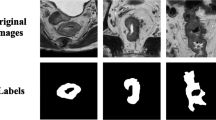Abstract
Segmentation of the prostate bed, the residual tissue after the removal of the prostate gland, is an essential prerequisite for post-prostatectomy radiotherapy but also a challenging task due to its non-contrast boundaries and highly variable shapes relying on neighboring organs. In this work, we propose a novel deep learning-based method to automatically segment this “invisible target”. As the main idea of our design, we expect to get reference from the surrounding normal structures (bladder&rectum) and take advantage of this information to facilitate the prostate bed segmentation. To achieve this goal, we first use a U-Net as the backbone network to perform the bladder&rectum segmentation, which serves as a low-level task that can provide references to the high-level task of the prostate bed segmentation. Based on the backbone network, we build a novel attention network with a series of cascaded attention modules to further extract discriminative features for the high-level prostate bed segmentation task. Since the attention network has one-sided dependency on the backbone network, simulating the clinical workflow to use normal structures to guide the segmentation of radiotherapy target, we name the final composition model asymmetrical multi-task attention U-Net. Extensive experiments on a clinical dataset consisting of 186 CT images demonstrate the effectiveness of this new design and the superior performance of the model in comparison to the conventional atlas-based methods for prostate bed segmentation. The source code is publicly available at https://github.com/superxuang/amta-net.
This work was supported in part by NIH Grant CA206100.
Access this chapter
Tax calculation will be finalised at checkout
Purchases are for personal use only
Similar content being viewed by others
References
Delpon, G., et al.: Comparison of automated atlas-based segmentation software for postoperative prostate cancer radiotherapy. Front. Oncol. 6, 178 (2016)
He, K., Cao, X., Shi, Y., Nie, D., Gao, Y., Shen, D.: Pelvic organ segmentation using distinctive curve guided fully convolutional networks. IEEE Trans. Med. Imaging 38(2), 585–595 (2018)
Hwee, J., et al.: Technology assessment of automated atlas based segmentation in prostate bed contouring. Radiat. Oncol. 6(1), 110 (2011)
Latorzeff, I., Sargos, P., Loos, G., Supiot, S., Guerif, S., Carrie, C.: Delineation of the prostate bed: the “invisible target” is still an issue? Front. Oncol. 7, 108 (2017)
Lian, C., Liu, M., Zhang, J., Shen, D.: Hierarchical fully convolutional network for joint atrophy localization and Alzheimer’s disease diagnosis using structural MRI. IEEE Trans. Pattern Anal. Mach. Intell. 42(4), 880–893 (2020)
Lian, C., Zhang, J., Liu, M., Zong, X., Hung, S.C., Lin, W., Shen, D.: Multi-channel multi-scale fully convolutional network for 3D perivascular spaces segmentation in 7T MR images. Med. Image Anal. 46, 106–117 (2018)
Liu, S., Johns, E., Davison, A.J.: End-to-end multi-task learning with attention. In: Proceedings of the IEEE Conference on Computer Vision and Pattern Recognition, pp. 1871–1880 (2019)
Long, J., Shelhamer, E., Darrell, T.: Fully convolutional networks for semantic segmentation. In: Proceedings of the IEEE Conference on Computer Vision and Pattern Recognition, pp. 3431–3440 (2015)
Michalski, J.M., et al.: Development of RTOG consensus guidelines for the definition of the clinical target volume for postoperative conformal radiation therapy for prostate cancer. Int. J. Radiat. Oncol. Biol. Phys. 76(2), 361–368 (2010)
Poortmans, P., Bossi, A., Vandeputte, K., Bosset, M., Miralbell, R., Maingon, P., Boehmer, D., Budiharto, T., Symon, Z., Van den Bergh, A.C., et al.: Guidelines for target volume definition in post-operative radiotherapy for prostate cancer, on behalf of the EORTC radiation oncology group. Radiother. Oncol. 84(2), 121–127 (2007)
Ronneberger, O., Fischer, P., Brox, T.: U-Net: convolutional networks for biomedical image segmentation. In: Navab, N., Hornegger, J., Wells, W.M., Frangi, A.F. (eds.) MICCAI 2015. LNCS, vol. 9351, pp. 234–241. Springer, Cham (2015). https://doi.org/10.1007/978-3-319-24574-4_28
Sidhom, M.A., Kneebone, A.B., Lehman, M., Wiltshire, K.L., Millar, J.L., Mukherjee, R.K., Shakespeare, T.P., Tai, K.H.: Post-prostatectomy radiation therapy: consensus guidelines of the Australian and New Zealand radiation oncology genito-urinary group. Radiother. Oncol. 88(1), 10–19 (2008)
Wang, S., He, K., Nie, D., Zhou, S., Gao, Y., Shen, D.: Ct male pelvic organ segmentation using fully convolutional networks with boundary sensitive representation. Med. Image Anal. 54, 168–178 (2019)
Wiltshire, K.L., et al.: Anatomic boundaries of the clinical target volume (prostate bed) after radical prostatectomy. Int. J. Radiat. Oncol. Biol. Phys. 69(4), 1090–1099 (2007)
Xu, X., Zhou, F., Liu, B.: Automatic bladder segmentation from CT images using deep CNN and 3d fully connected CRF-RNN. Int. J. Comput. Assist. Radiol. Surg. 13(7), 967–975 (2018)
Author information
Authors and Affiliations
Corresponding author
Editor information
Editors and Affiliations
1 Electronic supplementary material
Below is the link to the electronic supplementary material.
Rights and permissions
Copyright information
© 2020 Springer Nature Switzerland AG
About this paper
Cite this paper
Xu, X. et al. (2020). Asymmetrical Multi-task Attention U-Net for the Segmentation of Prostate Bed in CT Image. In: Martel, A.L., et al. Medical Image Computing and Computer Assisted Intervention – MICCAI 2020. MICCAI 2020. Lecture Notes in Computer Science(), vol 12264. Springer, Cham. https://doi.org/10.1007/978-3-030-59719-1_46
Download citation
DOI: https://doi.org/10.1007/978-3-030-59719-1_46
Published:
Publisher Name: Springer, Cham
Print ISBN: 978-3-030-59718-4
Online ISBN: 978-3-030-59719-1
eBook Packages: Computer ScienceComputer Science (R0)





